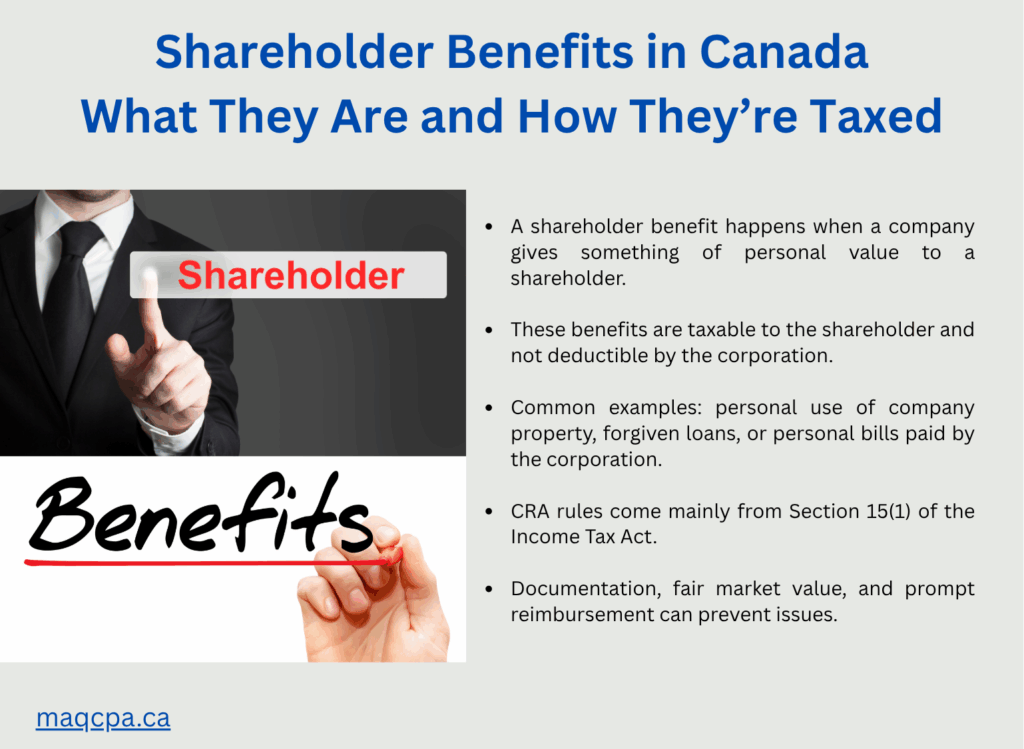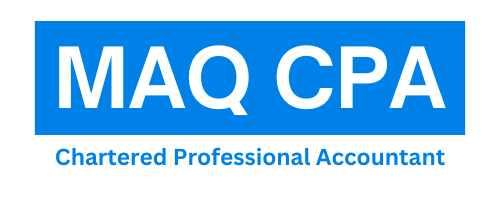If you own shares in your own company — maybe a small incorporated business or professional corporation — you’ve probably heard the term “shareholder benefits” before.
It sounds simple, but when it comes to taxes, this is one area where the Canada Revenue Agency (CRA) keeps a close eye.
In plain language, a shareholder benefit is when your company gives you something of personal value — like paying your phone bill or letting you use a company car — and you don’t fully pay for it. CRA may then say, “That’s a taxable benefit.”
Understanding how this works can save you from unexpected taxes, penalties, or even a CRA audit.

Key Takeaways
- A shareholder benefit happens when a company gives something of personal value to a shareholder.
- These benefits are taxable to the shareholder and not deductible by the corporation.
- Common examples: personal use of company property, forgiven loans, or personal bills paid by the corporation.
- CRA rules come mainly from Section 15(1) of the Income Tax Act.
- Documentation, fair market value, and prompt reimbursement can prevent issues.
- A corporate tax accountant in Toronto or CPA in Canada can help report or avoid these situations correctly.
What Is a Shareholder Benefit?
Let’s keep this simple:
A shareholder benefit happens when your corporation gives you something personal that isn’t part of your salary or dividend — and you didn’t pay fair value for it.
A simple example:
Samantha owns a small marketing company called Sammie Creative Inc.
In 2025, the company:
- Pays her home internet bill.
- Covers her family’s cell phone plan.
- Lets her use the company’s SUV for a personal trip.
To Samantha, these might feel like normal perks.
But to the CRA, they’re personal benefits — and Samantha may need to pay tax on them.
CRA’s Rule: Section 15(1) of the Income Tax Act
The main law about shareholder benefits is Section 15(1) of the Income Tax Act.
It says that if a corporation gives any benefit to a shareholder — directly or indirectly — that isn’t already taxed as salary or dividends, the shareholder must include it in their income.
Put simply:
If your company gives you something personal, CRA treats it as income unless you pay the company back or prove it’s a true business expense.
This rule ensures that shareholders don’t use corporate funds for personal use without paying tax.
Common Examples of Shareholder Benefits
Let’s look at what CRA often sees as shareholder benefits:
| Situation | What CRA Might Say |
| Using the company car for personal trips | Personal benefit based on fair rental value |
| Company paying your personal cell phone, internet, or gym membership | Shareholder benefit (unless clearly business-related) |
| Personal travel or vacations paid by the business | 100% personal benefit |
| Corporation paying your personal home expenses | Shareholder benefit |
| Loan from the company that is later forgiven | Treated as income (Section 15(1.2)) |
| Buying an asset (like property) from the company at a discount | Difference between market value and price is a taxable benefit |
How the CRA Calculates the Value
CRA uses fair market value (FMV) — what the item or service would cost if you bought it yourself.
Example:
If your company lets you use a corporate condo that would normally rent for $2,000 a month, and you pay nothing, CRA says you got a $24,000 benefit for the year (12 × $2,000).
That $24,000 gets added to your personal taxable income.
When a Shareholder Benefit Does Not Apply
There are exceptions.
CRA usually won’t call something a shareholder benefit if:
- It’s a legitimate business expense (for example, you used the company car to visit clients).
- You reimburse the company the full fair value right away.
- It’s part of a formal employment arrangement (like a T4 benefit already taxed).
- The benefit is given at fair market value and is part of an arm’s-length transaction.
The key idea is intention and fairness — if the benefit looks like normal business or compensation, it may not trigger Section 15(1).
How to Report Shareholder Benefits
For the Shareholder
- You must include the value of the benefit in your personal income tax return for the year you received it.
- If you’re both a shareholder and employee, it might appear on your T4 slip (employment benefit).
- If it’s only a shareholder benefit (not related to employment), it usually goes on a T5 slip (“Other income”).
For the Corporation
- The company must report the benefit on the proper T-slip (T4 or T5).
- The company cannot deduct the cost of a shareholder benefit on its corporate tax return.
- It should record the transaction in its books as a non-deductible expense.
If GST/HST applies to the benefit (for example, when a company-owned asset is used personally), the company may also need to self-assess GST/HST. (CRA Publication G400-3-2)
Real-Life Example: How It Works
Example 1 — The Company Car
- Alex owns A-Plus Renovations Inc.
- The company owns a truck used for business and personal errands.
- Alex drives it 75% for work, 25% for personal use.
CRA might say the personal 25% is a taxable benefit.
If the truck’s annual operating cost is $10,000, Alex may have to include $2,500 (25%) in his personal income as a shareholder benefit.
Example 2 — Loan Forgiveness
- Your corporation lent you $20,000 as a shareholder loan.
- You never repaid it.
Under Section 15(1.2), CRA can say that the $20,000 is a shareholder benefit (taxable as income to you).
How to Avoid Shareholder Benefit Issues
Here’s how to stay on CRA’s good side:
✅ Document everything.
Keep receipts, contracts, and logs showing business purpose.
✅ Reimburse quickly.
If you use company property or funds personally, pay the company back at fair market value.
✅ Avoid “hidden” perks.
Even small personal benefits can add up.
✅ Consult a corporate tax accountant or CPA.
A professional tax accountant can tell you whether a perk is safe or if CRA might call it a benefit.
The Risks of Ignoring the Rules
If CRA finds you’ve received unreported shareholder benefits:
- You may owe personal income tax on those benefits.
- The corporation may be denied deductions and pay more corporate tax.
- Interest and penalties may apply for late or incorrect reporting.
- Repeated issues can trigger a CRA audit.
This is why many owner-managers work closely with a business tax accountant Scarborough or CPA Scarborough to review their books before filing.
FAQs – Shareholder Benefits
1. What’s the difference between a shareholder benefit and an employee benefit?
If you get something because you work for the company (like a work phone), it’s usually an employee benefit (taxed on a T4). If you get it because you’re a shareholder (like free use of company property), it’s a shareholder benefit (taxed under Section 15(1)).
2. What if my company pays a personal expense by accident?
If you reimburse the company quickly (ideally within the same fiscal year), CRA usually won’t count it as a benefit. But keep records to prove the repayment.
3. Are small perks, like coffee or team lunches, taxable benefits?
Generally no. These are minor or reasonable business hospitality — “non-material” benefits.
4. What if I sell personal property to my corporation or buy from it?
If the price isn’t at fair market value, CRA can assess a shareholder benefit equal to the difference.
5. Can a shareholder benefit be reversed later?
If you discover an issue and pay back the full value before CRA audits, you may be able to reduce or eliminate the benefit. A tax accountant Toronto can help document this properly.
Consult a Tax Accountant Toronto or a Corporate Tax Accountant Scarborough to Avoid Costly Mistakes
Shareholder benefits might seem harmless — after all, it’s your company. But CRA sees your corporation as a separate legal person. When it pays your personal expenses or gives you perks, it’s giving you income, and that’s taxable.
Schedule a consultation with MAQ CPA firm’s business tax accountant Toronto to help you identify and fix shareholder benefit issues before CRA does.
Disclaimer
The information provided in this blog is for general informational purposes only and does not constitute professional accounting, tax, financial, or legal advice. While we strive to ensure the accuracy and timeliness of the content, the information may not apply to your specific situation or reflect the most current legislative changes. Readers are strongly advised to consult a qualified legal or tax professional before making any decisions based on the content of this blog. MAQ CPA and its representatives disclaim any liability for any loss or damage incurred as a result of reliance on any information provided herein.
